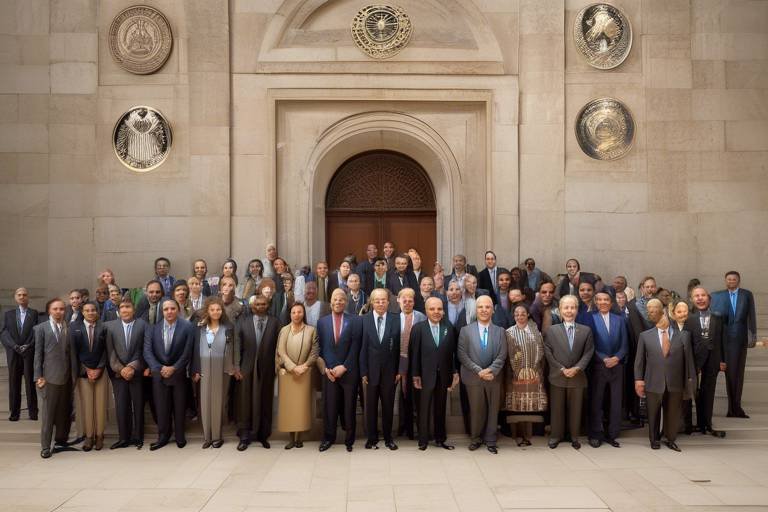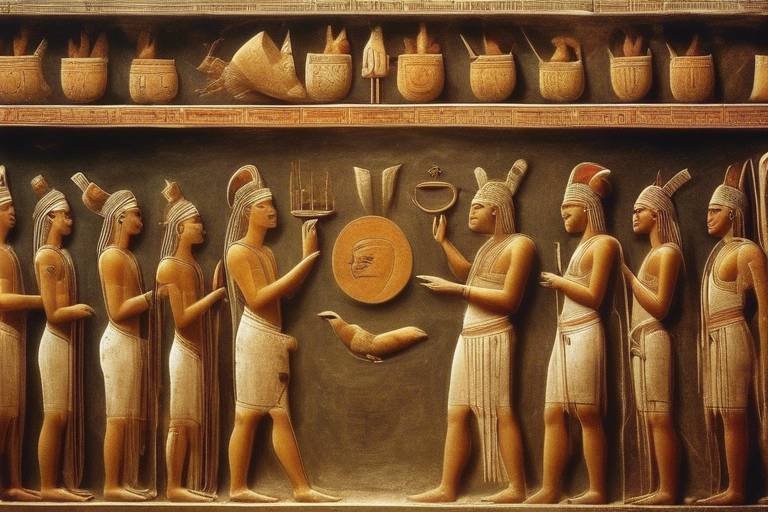The Evolution of Shintoism in Ancient Japan
Shintoism, the indigenous religion of Japan, has a rich and diverse history that dates back to ancient times. The evolution of Shintoism in ancient Japan is a fascinating journey that reflects the spiritual beliefs and cultural practices of the Japanese people. From its early origins rooted in the reverence for kami, or spirits, to its integration with the Japanese state and society, Shintoism has undergone significant transformations over the centuries.
The ancient origins of Shinto can be traced back to the early beliefs, practices, and rituals that shaped the foundation of this unique religion. Central to Shintoism is the concept of kami, the divine spirits that are believed to reside in natural elements such as mountains, rivers, and trees. The connection to nature is a fundamental aspect of Shinto beliefs, emphasizing harmony and respect for the environment.
During the feudal era in Japan, Shintoism played a crucial role in shaping the social and political landscape of the country. The samurai class, with its warrior ethos and code of honor, had strong ties to Shinto beliefs. Additionally, the influence of Buddhist practices on Shinto rituals and ceremonies created a syncretic relationship between the two religions, blending elements of both traditions.
The Meiji Restoration marked a significant turning point in the history of Shintoism, leading to the separation of Shinto and Buddhism and the promotion of State Shinto as a tool for nationalism and imperialism. The revitalization of Shinto as a state religion sought to unify the Japanese people under a common spiritual identity and reinforce loyalty to the emperor.
In modern Japan, Shintoism continues to play a vital role in the cultural traditions and practices of the Japanese people. From traditional festivals and ceremonies to daily rituals and prayers, Shinto remains deeply ingrained in the fabric of Japanese society. The adaptability of Shinto to the modern world reflects its enduring relevance and significance in contemporary Japan.
Shinto shrines are iconic symbols of the religion, featuring unique architectural designs and symbolic elements that reflect the spiritual essence of Shinto beliefs. These sacred spaces serve as places of worship and spiritual connection, inviting visitors to experience the tranquility and beauty of Shinto traditions.
Rituals and ceremonies are central to Shinto practice, encompassing a wide range of observances that celebrate nature, honor ancestors, and seek blessings from the kami. Purification rites, offerings of food and sake, and seasonal festivals are integral parts of Shinto rituals that highlight the cyclical rhythms of life and the interconnectedness of all beings.
The relationship between Shintoism and Japanese national identity is a topic of ongoing debate, with discussions surrounding the role of Shinto in contemporary society and the challenges of preserving traditional beliefs in a rapidly changing world. The enduring influence of Shinto on Japanese culture and spirituality continues to shape the collective identity of the Japanese people.
Beyond Japan, Shintoism has had a global impact on popular culture, art, and philosophy, spreading its influence and promoting Japanese heritage and spirituality internationally. The unique blend of tradition and modernity in Shinto beliefs has captivated people around the world, inspiring creativity and appreciation for the rich cultural heritage of Japan.

Ancient Origins of Shinto
Shinto, the indigenous religion of Japan, has ancient origins deeply rooted in the country's history and culture. The early beliefs and practices that formed the foundation of Shintoism date back to prehistoric times when the ancient Japanese people revered kami, the spirits believed to inhabit natural elements such as mountains, rivers, and trees. These kami were seen as powerful entities that influenced human life and the environment, leading to the development of rituals and ceremonies to honor and communicate with them.
Central to Shinto beliefs is the concept of purity and harmony with nature. The Japanese people viewed the natural world as sacred and believed in the interconnectedness of all living beings. This reverence for nature shaped the early rituals of Shinto, which focused on purification, offerings to kami, and celebrations of seasonal changes. These practices aimed to maintain balance and ensure the well-being of individuals, communities, and the land.
Over time, Shintoism became intertwined with the social and political structures of ancient Japan, influencing the religious practices of the imperial court, aristocracy, and common people. Temples and shrines dedicated to kami were built across the country, serving as sacred spaces for worship and spiritual reflection. The architectural design of these shrines reflected the natural surroundings and embodied the principles of Shinto aesthetics.
Shinto rituals were performed to mark important events such as harvests, births, weddings, and funerals, emphasizing the cyclical nature of life and the interconnectedness of past, present, and future generations. These ceremonies were conducted by priests and priestesses who acted as intermediaries between humans and kami, conveying prayers and offerings on behalf of the community.
As Shintoism evolved over the centuries, it absorbed influences from other belief systems such as Buddhism and Confucianism, leading to a syncretic approach to spirituality in Japan. Despite these influences, Shinto retained its distinctive characteristics and continued to play a significant role in shaping Japanese culture, ethics, and worldview.

Shinto in Feudal Japan
During the feudal era in Japan, Shintoism played a significant role in shaping the spiritual and cultural landscape of the country. The belief in kami, the divine spirits, was deeply intertwined with the daily lives of the people, influencing their values, traditions, and practices. Shinto shrines served as focal points for communities, where rituals and ceremonies were conducted to honor the kami and seek their blessings for prosperity and protection.
One of the notable aspects of Shinto in feudal Japan was its relationship with the samurai class. Samurai warriors, known for their loyalty, honor, and discipline, often followed Shinto rituals before battles to seek divine favor and guidance. The ethical code of bushido, which emphasized virtues such as courage, integrity, and self-discipline, was influenced by Shinto principles of respect for nature and the spirits.
Despite the prominence of Shinto, the feudal era also saw the influence of Buddhist practices on Shinto rituals and ceremonies. Buddhism, introduced to Japan from China and Korea, coexisted with Shintoism, leading to a syncretic blend of beliefs and practices. This fusion of traditions gave rise to unique cultural expressions, such as the incorporation of Buddhist elements in Shinto festivals and the construction of shrines with both Shinto and Buddhist features.
Moreover, the patronage of powerful feudal lords and the imperial court contributed to the growth and patronage of Shinto shrines and rituals. The establishment of major shrines, such as Ise Grand Shrine and Izumo Taisha, symbolized the spiritual unity and divine protection of the nation. These sacred sites became centers of pilgrimage and worship, attracting devotees from all walks of life.
Overall, the feudal period marked a dynamic phase in the evolution of Shintoism, where it interacted with various social, political, and religious influences to shape the cultural identity of Japan. The enduring legacy of Shinto in feudal Japan continues to resonate in the country's traditions, values, and spiritual practices to this day.

Meiji Restoration and Shinto Revival
Exploring the historical development and transformation of Shintoism, the indigenous religion of Japan, from its ancient roots to its integration with the Japanese state and society over the centuries.
The Meiji Restoration marked a pivotal moment in the history of Shintoism, reshaping its role in Japanese society and culture. Following centuries of Buddhist influence and the amalgamation of Shinto and Buddhist practices, the Meiji government initiated a radical shift towards the revitalization of Shinto as a distinct and nationalistic faith.
One of the key reforms during this period was the official separation of Shinto and Buddhism, known as Shinbutsu Bunri. This policy aimed to disentangle the two religions, emphasizing the unique identity of Shinto and promoting it as a symbol of Japan's spiritual heritage.
State Shinto emerged as a state-sponsored form of the religion, emphasizing the divine status of the Emperor and promoting loyalty to the imperial institution. Shinto rituals and ceremonies were redefined to emphasize nationalistic values, with the Emperor positioned as a central figure in the religious and political landscape.
The Meiji government utilized Shintoism as a tool for nation-building and modernization, fostering a sense of unity and identity among the Japanese populace. Shinto shrines became focal points for public ceremonies and patriotic displays, reinforcing the connection between religion, state, and society.
Despite the efforts to revive and promote Shinto as a unifying force, the Meiji Restoration also sparked debates and controversies regarding the role of religion in governance and the implications of state-sponsored spirituality. Critics raised concerns about the manipulation of religious beliefs for political purposes and the erosion of traditional practices in the face of modernization.
Nevertheless, the Meiji era set the stage for the enduring legacy of Shintoism in Japan, shaping its contemporary practice and cultural significance. The revival of Shinto during this period not only redefined the relationship between religion and the state but also influenced the construction of Japanese national identity and values.
Q: Is Shintoism still practiced in modern Japan?
A: Yes, Shintoism remains a vibrant and integral part of Japanese society, with millions of adherents participating in rituals, ceremonies, and festivals throughout the year.
Q: What role does Shinto play in Japanese culture?
A: Shinto influences various aspects of Japanese culture, from architecture and art to social customs and traditions. It continues to shape the spiritual and ethical values of the Japanese people.
Q: How has Shintoism influenced global culture?
A: The principles of Shintoism, such as reverence for nature and ancestral spirits, have resonated beyond Japan, influencing art, philosophy, and popular culture worldwide.

Shinto in Modern Japan
Shintoism in modern Japan continues to play a significant role in the country's cultural and spiritual landscape. With its deep roots in ancient traditions and beliefs, Shinto has evolved to adapt to the changing times while maintaining its core principles. Today, Shinto shrines are not only places of worship but also serve as cultural landmarks that attract visitors from around the world.
One of the key aspects of Shinto in modern Japan is its connection to seasonal festivals and ceremonies. These events are marked by vibrant celebrations that honor nature, harvests, and ancestral spirits. From the iconic cherry blossom festivals in spring to the elaborate rituals of New Year's celebrations, Shinto rituals continue to be an integral part of Japanese society.
Moreover, Shintoism in modern Japan is closely intertwined with the concept of purity and cleanliness. Purification rites, known as misogi, are performed to cleanse the body and soul, reflecting the belief in the importance of spiritual purity in Shinto practice. These rituals are often carried out before entering a shrine or participating in other religious ceremonies.
Shinto architecture also reflects the modern adaptation of traditional beliefs. Shinto shrines are characterized by their simple yet elegant designs, often featuring distinctive torii gates, sacred ropes called shimenawa, and wooden structures that blend harmoniously with the natural surroundings. The architecture of Shinto shrines is a testament to the reverence for nature and the kami spirits that are central to Shinto beliefs.
Furthermore, Shintoism in modern Japan is not limited to religious observance but extends to various aspects of daily life. Many Japanese people incorporate Shinto practices into their routines, such as visiting shrines for blessings, participating in festivals, and seeking guidance from kami spirits. The influence of Shinto can be seen in traditional arts, literature, and even modern popular culture, highlighting its enduring impact on Japanese society.
In conclusion, Shintoism in modern Japan remains a vibrant and essential part of the country's cultural heritage. Its ability to adapt to changing times while preserving ancient traditions is a testament to the enduring power of this indigenous religion. As Japan continues to embrace modernity, Shintoism serves as a bridge between the past and the present, connecting people to their roots and fostering a sense of spiritual connection with the world around them.

Shinto Shrines and Architecture
Shinto shrines in Japan are not just places of worship but also architectural marvels that reflect the deep spiritual connection between the people and nature. These shrines are meticulously designed to harmonize with their natural surroundings, often nestled in serene forests or atop picturesque hills. The architecture of Shinto shrines is characterized by simplicity, with wooden structures that blend seamlessly with the environment, creating a tranquil atmosphere for visitors.
One of the most distinctive features of Shinto shrine architecture is the torii gate, a traditional symbol marking the transition from the mundane to the sacred. These iconic gates, usually made of wood or stone, stand at the entrance of shrines, inviting visitors to enter a realm where the divine and earthly realms intersect. The torii gate is not just a physical structure but a spiritual gateway, symbolizing the boundary between the profane world and the realm of the kami.
Shinto shrines are often built following the principles of Shinto architecture, which emphasize the use of natural materials such as wood, paper, and thatch. The design of the shrines is based on the concept of purity and simplicity, reflecting the Shinto belief in the inherent sacredness of nature. The layout of the shrines is carefully planned to create a sense of harmony and balance, with each element serving a symbolic purpose in the worship of the kami.
Another key architectural feature of Shinto shrines is the honden, or main hall, where the kami are enshrined and worshipped. The honden is typically a single-room structure with a thatched roof and minimal decoration, embodying the Shinto aesthetic of understated elegance. Inside the honden, visitors can offer prayers, make offerings, and connect with the divine presence of the kami.
Shinto architecture also incorporates elements of Buddhist influence, reflecting the historical interaction between the two religions in Japan. This fusion of Shinto and Buddhist styles can be seen in the design of some shrines, where intricate carvings, pagoda-like structures, and garden features blend the unique aesthetics of both traditions. Despite these influences, Shinto architecture remains distinct in its emphasis on simplicity, natural materials, and reverence for the natural world.

Shinto Rituals and Ceremonies
Shinto rituals and ceremonies form an integral part of the religious practices in Japan, reflecting the deep connection between the followers and the spiritual world. One of the central aspects of Shinto rituals is purification, known as "misogi," which involves cleansing the body and mind to purify the soul. This ritual often takes place at a water source, such as a river or a waterfall, symbolizing the washing away of impurities and negative energies.
Another significant ceremony in Shintoism is the offering of "tamagushi" - sacred branches of a sakaki tree adorned with paper streamers. These offerings are presented to the kami at shrines as a sign of respect and gratitude. The act of making offerings symbolizes the harmonious relationship between humans and the divine spirits, seeking blessings and protection in return.
Seasonal festivals, known as "matsuri," play a vital role in Shinto rituals, celebrating the changing seasons, agricultural abundance, and the cycle of nature. These festivals involve lively processions, traditional dances, and elaborate ceremonies to honor the kami and express gratitude for their blessings. Participants often wear colorful attire and carry portable shrines through the streets, creating a vibrant and festive atmosphere.
Harvest festivals, such as the "Niiname-sai," are held to give thanks for the year's harvest and pray for a bountiful crop in the coming year. During these ceremonies, the Emperor of Japan offers the first rice harvest to the sun goddess Amaterasu, symbolizing the sacred bond between the imperial family and the divine spirits. The rituals are performed with meticulous precision and solemnity, reflecting the reverence for nature and the agricultural traditions deeply rooted in Shinto beliefs.

Shintoism and Japanese Identity
Shintoism holds a significant place in shaping Japanese national identity, intertwining with the cultural fabric of the nation. The deep-rooted connection between the Japanese people and their indigenous religion reflects in various aspects of daily life, traditions, and societal norms. The belief in kami, the spirits that inhabit all things, underscores the reverence for nature and the interconnectedness of humans with the natural world.
Throughout history, Shintoism has been a unifying force, fostering a sense of shared heritage and identity among the Japanese population. The rituals and ceremonies practiced in Shinto shrines serve not only as religious observances but also as cultural expressions that reinforce a sense of belonging and continuity with the past. The emphasis on purity, harmony, and respect for ancestors resonates deeply within the Japanese psyche, shaping their values and behaviors.
However, the role of Shintoism in contemporary Japanese society has sparked debates and challenges regarding its influence on national identity. As Japan grapples with modernization, globalization, and changing social dynamics, the preservation of traditional beliefs faces scrutiny and adaptation. The delicate balance between preserving cultural heritage and embracing progress poses a complex dilemma for the Japanese people.
Moreover, the association of Shintoism with State Shinto during the Meiji era and World War II has raised questions about the politicization of religion and its impact on Japanese identity. The efforts to separate Shinto from government control and promote religious freedom have reshaped the perception of Shintoism in a modern, democratic Japan.
Despite these challenges, Shintoism continues to play a vital role in shaping Japanese identity, serving as a source of spiritual guidance, cultural pride, and communal solidarity. The ongoing evolution of Shintoism reflects the dynamic nature of Japanese society, where tradition and innovation coexist in a delicate balance, defining the essence of Japanese identity in the 21st century.

Global Influence of Shintoism
Shintoism, the indigenous religion of Japan, has transcended its geographical boundaries to exert a global influence on various aspects of culture, art, and philosophy. The unique spiritual practices and beliefs of Shinto have captivated individuals worldwide, leading to a growing interest in understanding and incorporating its principles into diverse societies.
One of the key ways in which Shintoism has made its mark globally is through its profound impact on popular culture. From anime and manga to traditional arts such as tea ceremonies and flower arranging, elements of Shinto spirituality can be seen woven into the fabric of Japanese cultural exports that have gained international acclaim. The reverence for nature, harmonious living, and respect for ancestral spirits that define Shinto teachings have resonated with people from different backgrounds, fostering a deeper appreciation for Japanese heritage.
Furthermore, the artistic expressions inspired by Shinto beliefs have transcended borders, influencing contemporary art forms and architectural designs around the world. The minimalist aesthetic, connection to nature, and emphasis on simplicity and purity that characterize Shinto architecture and design have found echoes in modern structures and artistic creations, reflecting a global appreciation for the spiritual essence of Shintoism.
Moreover, the philosophical underpinnings of Shintoism, which emphasize the interconnectedness of all beings and the sacredness of life, have contributed to shaping ethical frameworks and environmental movements on a global scale. The principles of harmony, gratitude, and reverence for the natural world espoused by Shinto teachings have inspired individuals and organizations to advocate for sustainable practices, conservation efforts, and the preservation of cultural heritage worldwide.
In essence, the global influence of Shintoism extends far beyond its origins in Japan, serving as a source of inspiration and spiritual guidance for people across continents. As the world becomes increasingly interconnected, the timeless wisdom and cultural richness of Shinto continue to resonate with individuals seeking a deeper understanding of themselves, their place in the world, and the interconnected web of existence that binds us all.
Frequently Asked Questions
- What is Shintoism?
Shintoism is the indigenous religion of Japan that focuses on the worship of kami, which are spirits or deities believed to inhabit the natural world. It emphasizes rituals, traditions, and a deep connection to nature.
- How old is Shintoism?
Shintoism dates back to ancient times in Japan, with its roots tracing back to prehistoric beliefs and practices. It has evolved over centuries, adapting to various historical and cultural changes.
- Are there specific rituals in Shintoism?
Yes, Shintoism involves a variety of rituals and ceremonies, including purification rites, offerings to kami, and seasonal festivals. These rituals play a significant role in connecting individuals to the spiritual world and maintaining harmony with nature.
- How is Shintoism practiced in modern Japan?
In modern Japan, Shintoism is practiced through visits to shrines, participation in festivals, and observing traditional ceremonies. It remains a vital part of Japanese cultural identity and is often intertwined with daily life and societal customs.
- Is Shintoism only practiced in Japan?
While Shintoism originated in Japan, its influence has spread globally, impacting various aspects of popular culture, art, and philosophy. It serves as a representation of Japanese heritage and spirituality beyond the borders of the country.



















